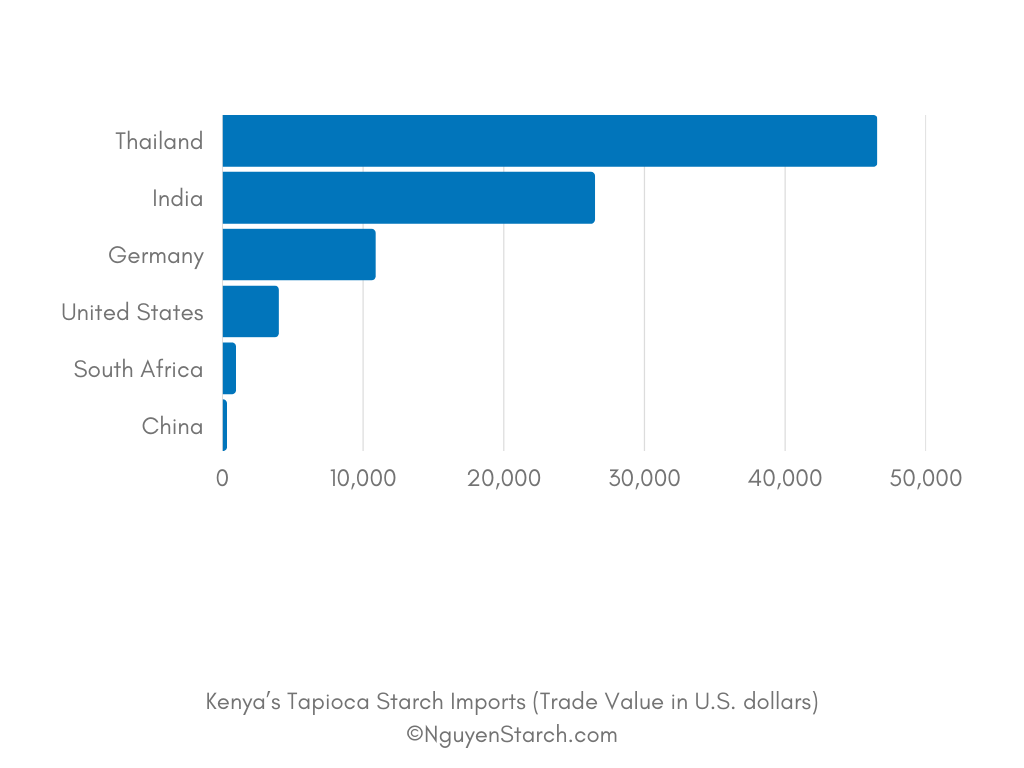Kenya, an emerging player in the global tapioca starch market, has witnessed notable trends in both its export and import activities.

Exports
In 2021, Kenya’s tapioca starch exports amounted to $19.6k, positioning the country as the 59th largest exporter of this product globally. Tapioca starch ranked as the 2025th most exported commodity in Kenya during the same year. Notably, the primary destinations for Kenya’s tapioca starch exports were Tanzania ($18.5k), the United States ($1k), the United Arab Emirates ($81), and Sweden ($19).
Kenya experienced significant growth in its export markets for tapioca starch between 2020 and 2021. Particularly noteworthy expansions were observed in Tanzania ($18.5k), the United Arab Emirates ($81), and Sweden ($19), indicating a rising demand for Kenyan tapioca starch in these countries.
| Continent | Country | Trade Value |
| Africa | Tanzania | 18,534 |
| Asia | United Arab Emirates | 81 |
| Europe | Sweden | 19 |
| North America | United States | 1,000 |
Imports
In 2021, Kenya imported $89k worth of tapioca starch, ranking as the 89th largest importer of this product globally. Within Kenya, tapioca starch stood as the 3065th most imported item in the same year. The primary sources of Kenya’s tapioca starch imports were Thailand ($46.5k), India ($26.4k), Germany ($10.9k), the United States ($3.97k), and South Africa ($925).
Kenya witnessed notable growth in its import markets for tapioca starch between 2020 and 2021. Notable increases were observed in India ($6.66k), Germany ($6.61k), and the United States ($1.13k), highlighting the strengthening trade relations between Kenya and these countries in the tapioca starch industry.
| Continent | Country | Trade Value |
| Africa | South Africa | 925 |
| Asia | China | 284 |
| Asia | India | 26,444 |
| Asia | Thailand | 46,523 |
| Europe | Germany | 10,850 |
| North America | United States | 3,967 |
Tariffs
In 2018, the average tariff imposed on tapioca starch in Kenya was 9.78%. Notably, Angola, Benin, Burkina Faso, Botswana, and the Central African Republic implemented the highest import tariffs on tapioca starch, with a Most Favoured Nation duty rate treatment of 10%. These tariffs reflect the protective measures and trade policies implemented by these countries to regulate the inflow of tapioca starch imports.
Conclusion
Kenya’s position as an exporter and importer of tapioca starch signifies its growing presence in the global market. The country has witnessed promising growth in its export markets, with Tanzania, the United Arab Emirates, and Sweden emerging as key destinations for Kenyan tapioca starch. Meanwhile, Kenya relies on imports from Thailand, India, Germany, the United States, and South Africa to meet its tapioca starch demands. As trade policies and tariffs continue to shape the industry, stakeholders in the tapioca starch trade must remain vigilant about evolving market dynamics to capitalize on opportunities and navigate challenges effectively.
Data from BACI
